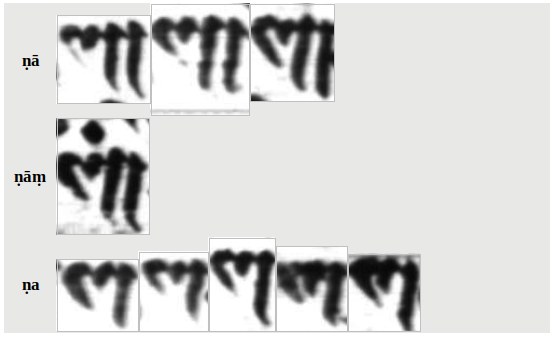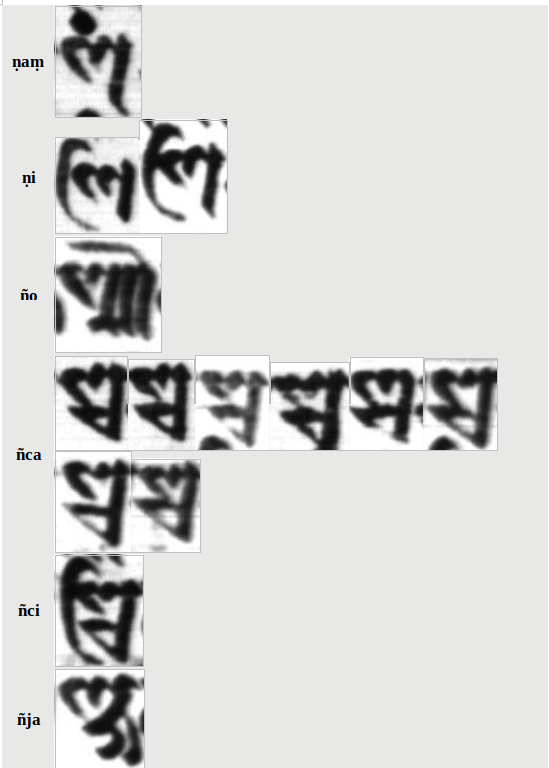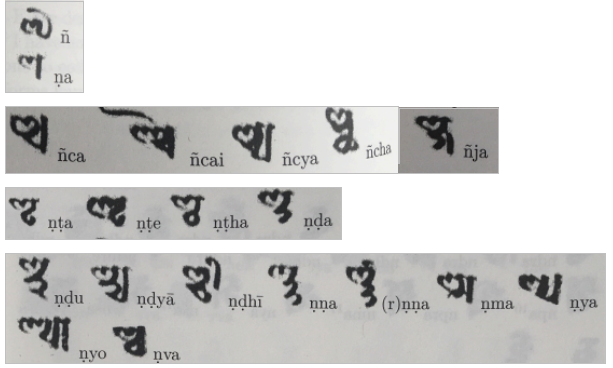Scribal Conventions
While transcribing the sixth chapter (adhyāya) of the Sūtrasthāna of the Suśrutasaṃhitā from an old handwritten manuscript in Newari script, MS Kathmandu NAK 1-1079, I came upon the conjunct consonants ñc, ñj (Devanāgarī ञ्च ञ्ज), etc. Samples are given in the figure below. These conjunct consonants seemed to me to have an initial ṇ (ण, the retroflex nasal) instead of the expected ñ (ञ, the palatal nasal).
I then referred to the rendering rules for depicting conjunct consonants in Newari script in a well-researched article “Proposal to Encode the Newar Script in ISO/IEC” by Anshuman Pandey . Pandey gives illustrations of how the consonant ñ (ञ) is written when it is part of a conjunct consonant and similarly what the consonant ṇ (ण) looks like in a conjunct consonant.


Based on this and seeing the exact similarity in the instances of ñ and ṇ in the manuscript that I was transcribing, I came to the understanding that the scribe has used the consonant ṇ in the place of ñ at all places where ñ is expected in a conjunct consonant.



I would like to clarify that I do not think that the scribe actually understood the words pañca as having a retroflex nasal consonant instead of a palatal nasal consonant and wrote it as paṇca for that reason. However, I am of the opinion that it was a convention among scribes to denote the consonant ñ as ṇ in conjunct consonants. It cannot be denied that the ṇ and ñ are exactly the same when in a conjunct consonant. There is no characteristic in the depiction of ñ when used as an initial consonant in a conjunct consonant that shows that it is a different consonant from ṇ. In the same way, there is no characteristic in the depiction of ṇ when used as an initial consonant in a conjunct consonant that shows that it is a different consonant from ñ. The reader can only tell that it is ṇ or ñ by the next consonant in the conjunction.[1]For example: If the next consonant is c then the previous consonant is ñ, and if the next consonant is ṭh then the previous consonant is ṇ.
In the conventions for writing ñ in Newari script, this character:

is used. However, Csaba Kiss’s paleography chart has quite a different character for denoting ñ .[2]I am grateful to Deepro Chakraborty for drawing this reference to my attention.

Thus, given that there are two very different ways of writing ñ, it is possible that the scribes denote ñ in this second way. But here also, in case of conjunct consonants, it is not possible to identify whether the initial consonant is ñ or ṇ simply by that consonant. Both of them look exactly the same when appearing as the initial consonant in a conjunction. We have to take into account the next consonant in order to correctly identify the previous consonant.
Regarding the question as to whether the consonant in a conjunction be transcribed as ñ or ṇ, I think that the consonant should be transcribed as ñ where ñ is expected and as ṇ where ṇ is expected. I think that it was just a scribal convention to write ñ and ṇ in the same way when in a conjunct consonant. Thus, assuming and accepting that the scribes were well acquainted with the differences between ñ and ṇ, and that it was their convention to denote them in the same way in a conjunct consonant without any separating characteristic to identify them as different from each other, it lies on the reader of the manuscript to differentiate the instances of ñ and ṇ in a conjunct consonant as understood from the other consonant in the conjunction.
In conclusion, I would say that immaterial of the method of writing ñ in a manuscript, when dealing with conjunct consonants we have to depend on the other consonant in order to identify whether the consonant in consideration is ṇ or ñ.